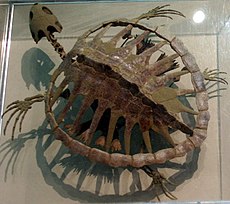Smoky Hill Chalk


The Smoky Hill Chalk is an Upper Cretaceous conservation Lagerstätte, or fossil-rich geological formation. It is known for its exceptionally well-preserved marine reptiles from the Western Inland Sea.[1]
The Smoky Hill Chalk outcrops in parts of northwest Kansas, its most famous localities for fossils, and in southeastern Nebraska. Large well-known fossils excavated from the Smoky Hill Chalk include marine reptiles such as plesiosaurs, large bony fish such as Xiphactinus, mosasaurs, pterosaurs (namely Pteranodon), flightless marine birds such as Hesperornis, and turtles. Many of the most well-known specimens of the marine reptiles were collected by dinosaur hunter Charles H. Sternberg and his son George. The son collected a unique fossil of the giant bony fish Xiphactinus audax with the skeleton of another bony fish, Gillicus arcuatus inside the larger one. Another excellent skeleton of Xiphactinus audax was collected by Edward Drinker Cope during the late nineteenth century heyday of American paleontology.[2]
References
[change | change source]- ↑ Bottjer, David J.; Etter, Walter; Hagadorn, James W.; Tang, Carol M., eds. (2002). Exceptional Fossil Preservation: a unique View on the evolution of marine life. Columbia University Press. ISBN 0231102550.
- ↑ Schwimmer, David R. (2002). King of the Crocodylians: the paleobiology of Deinosuchus. Indiana University Press. ISBN 025334087X.